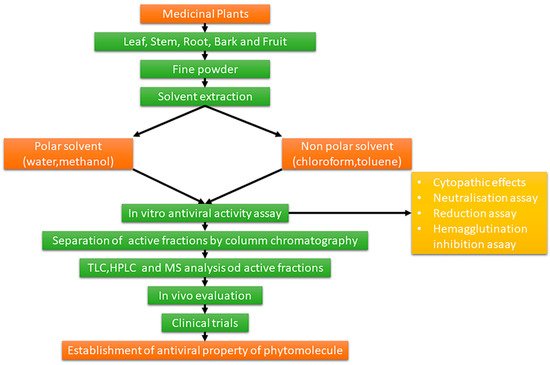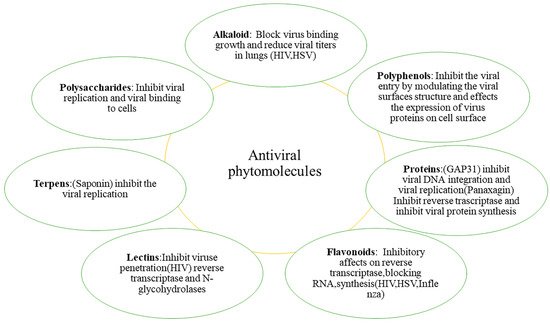
| Version | Summary | Created by | Modification | Content Size | Created at | Operation |
|---|---|---|---|---|---|---|
| 1 | Predrag Putnik | -- | 1294 | 2024-05-12 13:57:21 | | | |
| 2 | Jason Zhu | -32 word(s) | 1262 | 2024-05-13 07:59:40 | | |
Video Upload Options
Antiviral Agents from Plant refers to antiviral drugs derived from plants and plant foods.
1. Introduction
Plants and plant foods are known as major sources from which to extract secondary metabolites that can be employed for the synthesis of the same via their metabolic pathway along with the concept of genetic engineering [1]. Currently, epidemiological studies have demonstrated the health promoting potential of phytochemicals from fruits and vegetables, as well as their association with a lower risk for chronic diseases (e.g., cancer and cardiovascular diseases) [2].
Many investigations have been addressed towards the elucidation of the antiviral activities of compounds from plant world. Once the contribution and quality of the various phytochemicals have been ascertained, their biological activity must be tested using specific assays. The screening of biomolecules for antiviral activity comprises of a number of clinical trials for its teratogenicity, toxicological studies that are carried in vivo and the whole procedure for the same is depicted in Figure 1 [3][4].

Figure 1. Various processes that a plant has to undergo for the establishment of an appropriate activity for a molecule.
2. The Healing Potential of Medicinal Plants
2.1. Herbs Remedies for viRAL Diseases
Plant extracts commonly contain many classes of compounds and among these alkaloids, terpenes and polyphenols. These three classes represent the most widespread groups of secondary metabolites with biological activity, including the antiviral one studied by cell cultures and in vivo testing. Compounds belonging to these classes are often found in nature also in conjugated form. Along with this, various screening programs were instigated for the evaluation of antiviral activity of phytochemicals and the same was done through in vivo and in vitro assays.
2.2. Plant Extracts
To date, there is a lot of evidence confirming that viral infections can be treated by the antiviral drugs obtained by traditional medicine and herbal sources rich in phytochemicals. Figure 2 depicts the major phytochemical classes with antiviral activity.

Figure 2. Major groups of phytochemical classes presenting antiviral activities.
3. Phytochemicals
3.1. Flavonoids
Flavonoids have been studied for their potential antiviral activities and promising results have emerged from both in vitro and even in vivo studies. The next sub-paragraphs summarize the up-to-date evidences for antiviral activity of different flavonoids, together with the cellular and molecular mechanisms of action of these bioactive on viruses.
3.2. Coumarins and Arylcoumarins
Coumarins are considered good candidates for designing novel antiviral agents. In particular, these compounds have gained great attention in the last years for their correlation with orally bioavailable non-peptidic antiviral agents [5]. The most important coumarin derivatives reported as antiviral drugs belong to the class of 4-hydroxycoumarins, arylcoumarins, pyranocoumarins, furanocoumarins, 3-phenylcoumarins, 4-phenylcoumarins, coumarin-benzimidazoles conjugates, anilinocoumarins, 7-hydroxycoumarin analogues, coumestans, and toddacoumaquinone.
3.3. Resveratrol (Stilbenes)
Resveratrol belongs to the phenolic class of stilbenes. This phenolic compound characterizes mostly fermented grapes, mulberry, red wine, and peanuts, and it exists as both trans- and/or cis- isomer [6]. In the last years, several health-promoting activities have been accurately documented for this compounds [7], mainly related to its radical scavenging potential. Besides, it acts as prophylactic compound against cancers and viral infections.
3.4. Other Phenolic Compounds
Regarding other polyphenol classes, the most important compounds presenting antiviral activities can be listed under the class of lignans, tannins and hydroxyphenyl propenes.
Lignans are produced by various plant species. From a structural point of view, these molecules can be quite complex as they can be formed by a central nucleus consisting of two or more phenylpropanoid units. Lignans are phytoestrogens with antioxidant activity chemically similar to estrogen [8][9]. Nordihydroguaiaretic acid is lignan obtained from the perspired leaves of Larrea divaricata with antiviral activity against numerous viruses including HSV-1, HSV-2, HIV along with human papilloma [10].
Indeed, tannins showed a variety of biological effects, including antiviral activity [11]. In this regard, it must be emphasized that these molecules are capable of acting against many viruses including influenza virus A, HIV, HSV and rotavirus.
3.5. Terpenoids and Carotenoids
The antiviral activity of compounds belonging to the monoterpenes class has been extensively evaluated and some components such as isoborneol and borneol, have shown a high activity towards HSV-1. In this regard, isoborneol was found to have a total inhibition of HSV-1 replication already at a concentration of 0.06% [12]. Besides, terpenoids have been described also as anti-influenza, anti-SARS, anti-human enterovirus 71, anti-EBV, anti-HBS agents. Comprehensive information regarding their modes of action can be found elsewhere [13]. Little information exists regarding the potential anti-viral activity of carotenoids. In previous works, lutein showed antiviral activity against hepatitis B, since it inhibited the transcription of the virus [14].
3.6. Alkaloids
About 36 alkaloids isolated from Catharanthus lanceus or Catharanthus roseus were evaluated for antiviral activity against polio type III virus, and the most effective amongst all was pericalline. The piperidine ring and free hydroxyl groups present in the heterocyclic structure of this alkaloid were responsible for antiviral activity against HIV infection [15][16].
3.7. Organosulfur Compounds
Overall, the organosulfur compounds group includes not only isothiocyanates, but also indoles, allylic sulfur compounds, and sulforaphane. These compounds are widely known for their unique health-promoting properties. In this regard, their antioxidant antimicrobial and anti-inflammatory activities are already known. These compounds are particularly active against chronic diseases, especially in light of the beneficial effects due to their ability to reduce the level of low-density lipoproteins and carcinogens or toxic agents.
4. Plant Foods in the Preparation of Antiviral Drugs
Many plant foods have been deeply investigated for their immunomodulatory, antiviral properties as well as other relevant biological activities. Ginseng obtained from Panax ginseng has immuno-modulatory effect with antiviral property against RSV that was investigated by Seok and his coworkers [17]. Basil is a component of Ocimum basilicum L. and its antiviral activity was first investigated by Chiang and his co-workers. Oregano belongs to the herb of mint family and has antiviral and medicinal activity due to the presence of eatable carvacrol and other bioactive compounds. The collected data demonstrated the efficacy of fennel in many pharmacological properties done in vitro and in vivo, with reported anti-inflammatory, antimicrobial, antinociceptive, antiviral, antimutagenic. Garlic (Allium sativum L.) has known antiviral activity against human papilloma virus. Ahmed et al. (2017) found that ginger may have antiviral activity against avian influenza virus (H9N2), but further confirmations were required.Peppermint is derived from Mentha x piperita and consists of phenolic components including rosmarinic acid and flavonoids such as hesperidin, luteolin and eriocitrin. The volatile components are made of essential oils called menthol and menthone (principal volatile components in the essential oil) that have antimicrobial, antiviral, and antioxidant activity. Sambucus nigra L. or commonly called elderberry has been extensively used herb to treat influenza and colds. Licorice (Glycyrrhiza uralensis) is a commonly used herb for centuries in traditional Chinese medicine, containing approximately 20 triterpenoids and 300 flavonoids. Numerous studies demonstrated that among others, these metabolites have antimicrobial, antiviral, anti-inflammatory, and antitumor pharmacological functions. Rosemary (Rosmarinus officinalis L.) is a medicinal plant that is native to Mediterranean but cultivated in all parts of the world. Rosemary has bioactive phytomolecules with anti-inflammatory, antimicrobial, antiproliferative, antioxidant, and antitumor pharmacological activities.
To date, in the context of African Traditional Medicine, Moringa is among the most used by herbalist and medics to treat or manage disease of people living with HIV/AIDS (PLWHA). There are many positive feedbacks on its effectiveness in improving quality of patients’ lives and the ability to induce improvements of HIV/AIDS disease. Moeover, [18] studied the anti-influenza virus activity of total phenolics characterizing pomegranate peel extract and other fractions. Regarding the potential antiviral activity, [19] evaluated antiviral effects of blackberry extracts against HSV type 1; the authors demonstrated that blackberry extract (≥56 µg/mL) inhibited the early stages of HSV-1 replication in oral epithelial cells by >99%, showing potent virucidal activity.
References
- Atanasov, A.G.; Zotchev, S.B.; Dirsch, V.M.; Supuran, C.T. Natural products in drug discovery: Advances and opportunities. Nat. Rev. Drug Discov. 2021, 20, 1–17.
- Rodriguez-Casado, A. The Health Potential of Fruits and Vegetables Phytochemicals: Notable Examples. Crit. Rev. Food Sci. Nutr. 2016, 56, 1097–1107.
- Chuanasa, T.; Phromjai, J.; Lipipun, V.; Likhitwitayawuid, K.; Suzuki, M.; Pramyothin, P.; Hattori, M.; Shiraki, K. Anti-herpes simplex virus (HSV-1) activity of oxyresveratrol derived from Thai medicinal plant: Mechanism of action and therapeutic efficacy on cutaneous HSV-1 infection in mice. Antiviral. Res. 2008, 80, 62–70.
- Li, H.-B.; Chen, F. Isolation and purification of baicalein, wogonin and oroxylin A from the medicinal plant Scutellaria baicalensis by high-speed counter-current chromatography. J. Chromatogr. 2005, 1074, 107–110.
- Hassan, M.Z.; Osman, H.; Ali, M.A.; Ahsan, M.J. Therapeutic potential of coumarins as antiviral agents. Eur. J. Med. Chem. 2016, 123, 236–255.
- Abba, Y.; Hassim, H.; Hamzah, H.; Noordin, M.M. Antiviral Activity of Resveratrol against Human and Animal Viruses. Adv. Virol. 2015, 2015, 184241.
- Shankar, S.; Singh, G.; Srivastava, R.K. Chemoprevention by resveratrol: Molecular mechanisms and therapeutic potential. Front. Biosci. 2007, 12, 4839–4854.
- Konigheim, B.; Goleniowski, M.; Contigiani, M. Cytotoxicity and antiviral activity of a lignan extracted from Larrea divaricata. Drug Des. Rev. Online 2005, 2, 81–83.
- Rietjens, I.M.; Louisse, J.; Beekmann, K. The potential health effects of dietary phytoestrogens. Br. J. Pharmacol. 2017, 174, 1263–1280.
- Wang, Q.; Ding, Z.-H.; Liu, J.-K.; Zheng, Y.-T. Xanthohumol, a novel anti-HIV-1 agent purified from Hops Humulus lupulus. Antivir. Res. 2004, 64, 189–194.
- Vilhelmova-Ilieva, N.; Galabov, A.S.; Mileva, M. Tannins as Antiviral Agents, Tannins-Structural Properties, Biological Properties and Current Knowledge, Alfredo Aires, IntechOpen, doi:10.5772/intechopen.86490. 2019. Available online: https://www.intechopen.com/books/tannins-structural-properties-biological-properties-and-current-knowledge/tannins-as-antiviral-agents (accessed on 20 February 2021).
- Yang, W.; Chen, X.; Li, Y.; Guo, S.; Wang, Z.; Yu, X. Advances in pharmacological activities of terpenoids. Nat. Prod. Commun. 2020, 15, 1934578X20903555.
- Xiao, S.; Tian, Z.; Wang, Y.; Si, L.; Zhang, L.; Zhou, D. Recent progress in the antiviral activity and mechanism study of pentacyclic triterpenoids and their derivatives. Med. Res. Rev. 2018, 38, 951–976.
- Pang, R.; Tao, J.-Y.; Zhang, S.-L.; Zhao, L.; Yue, X.; Wang, Y.-F.; Ye, P.; Dong, J.-H.; Zhu, Y.; Wu, J.-G. In vitro antiviral activity of lutein against hepatitis B virus. Phytother. Res. 2010, 24, 1627–1630.
- Houghton, P.J. Chemistry and biological activity of natural and semi-synthetic chromone alkaloids. In Studies in Natural Products Chemistry; Elsevier: Amsterdam, The Netherlands, 2000; Volume 21, pp. 123–155.
- Wen, C.-C.; Kuo, Y.-H.; Jan, J.-T.; Liang, P.-H.; Wang, S.-Y.; Liu, H.-G.; Lee, C.-K.; Chang, S.-T.; Kuo, C.-J.; Lee, S.-S. Specific plant terpenoids and lignoids possess potent antiviral activities against severe acute respiratory syndrome coronavirus. J. Med. Chem. 2007, 50, 4087–4095.
- Lee, J.S.; Ko, E.-J.; Hwang, H.S.; Lee, Y.-N.; Kwon, Y.-M.; Kim, M.-C.; Kang, S.-M. Antiviral activity of ginseng extract against respiratory syncytial virus infection. Int. J. Mol. Med. 2014, 34, 183–190.
- Moradi, M.-T.; Karimi, A.; Shahrani, M.; Hashemi, L.; Ghaffari-Goosheh, M.-S. Anti-Influenza Virus Activity and Phenolic Content of Pomegranate (Punica granatum L.) Peel Extract and Fractions. Avicenna. J. Med. Biotechnol. 2019, 11, 285–291.
- Danaher, R.J.; Wang, C.; Dai, J.; Mumper, R.J.; Miller, C.S. Antiviral effects of blackberry extract against herpes simplex virus type 1. Oral Surg. Oral Med. Oral Pathol. Oral Radiol. Endodontology 2011, 112, 31–35.




